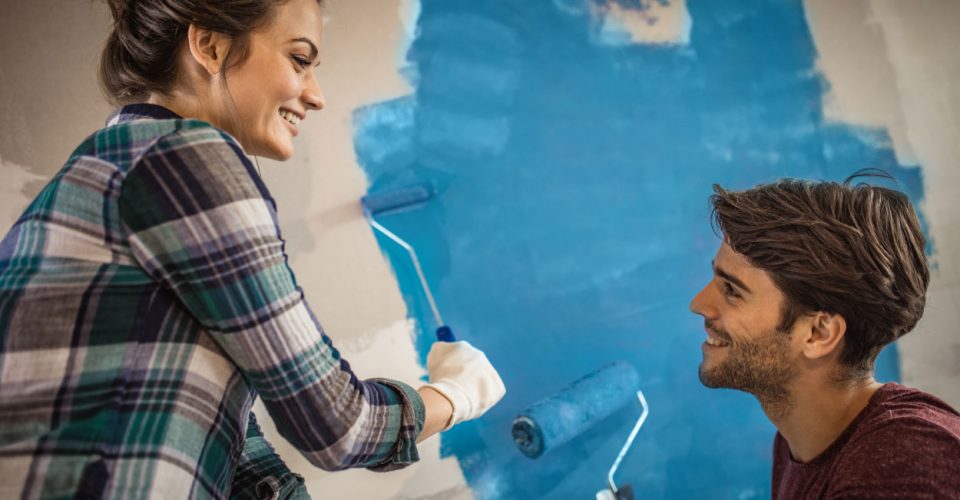How Soon Can You Paint New Plaster?
Painting new plaster is a fairly straightforward DIY task, but there are a few things you need to be aware of to ensure you’re doing it correctly.
Typically, a wall requires new plaster if its surface has become damaged, imperfections need to be covered, when undergoing renovations or simply because you require a smooth surface on which to paint. But before you go right ahead and paint on the new plaster, you need to make sure it’s ready for this to happen.
If you’ve found yourself wondering ‘how soon can you paint new plaster?’, you’ve come to the right place. In this blog, we’ll explain how to paint new plaster as well as how soon you can do so.

How Soon Can You Paint New Plaster?
Before painting plaster, especially if the plaster is new, it’s imperative that you wait for it to dry.
While the timescale for this is likely to vary, on average fresh plaster can take anywhere from four-six weeks to dry fully. This process can sometimes be faster during the summer months when the temperature is higher, and leaving windows open is a good way to speed this up.
A good way to see whether the plaster has dried or not is by checking the colour. As the plaster dries, it will leave lighter patches – indicating those areas are dry and ready.
It’s important to be patient and wait for the plaster to be fully dry, if not it could lead to issues like cracking or peeling in the future.
What Do I Need To Paint Plaster?
Once the plaster has dried, you’re ready to start painting. But before you begin it’s important you have the correct equipment and tools for the job.
This includes the following:
- Sandpaper
- Dust sheets
- Emulsion paint
- A bucket
- Water
- Top coat paint
- Paint brushes and rollers
Once you have all this equipment, you’re ready to paint the new plaster.
How To Paint New Plaster?
As mentioned above, painting new plaster is a fairly easy task. By following the steps below, you should find the process straightforward and easy to carry out, leaving you with a wonderfully painted wall no matter what room of the house you’re decorating.
Prepare the wall
The first step is preparation. Once you’ve made sure that the plaster is dry, you also need to check it’s smooth.
If the surface of the wall is uneven, you’ll be left with an inconsistent texture that can ruin its entire appearance. Inspect the wall closely and if you spot any lumps, bumps or imperfections, use sandpaper to even them out. A smooth surface will also ensure that paint adheres to the wall easier.
Before you go any further, make sure to lay a dust sheet on the ground and remove or cover any furniture. This way, you can guarantee that any spilt paint doesn’t cause damage or stains.
Mix your mist coat
Jumping straight in with paint can cause uneven brush strokes, so it’s always recommended to apply a primer to the wall first. In this situation, a mist coast works best.
A mist coat is essentially just a primer that is made up of emulsion paint that has been watered down to help your top coat properly adhere to the wall. Matt white emulsion paint is the best choice for this, as it’s fairly cheap and works well with all colours.
Mix the emulsion paint with water first. Use a clean bucket, and pour in the paint and water. Ten parts paint to one part water is normally a good rule of thumb when it comes to ratios for this, however, you should read the manufacturer’s instructions first.
Once you’ve poured everything into the bucket, give it a good mix.
Apply the mist coat
Next, it’s time to apply your mist coat to the newly plastered wall. Using a paint roller will be quicker but a brush will do just as good a job.
Apply the coat evenly across the entire surface.
The mixture will soak into your wall, making it easier for your top coat to stick to it.
Apply the top coat
Now for the final step, adding your top coat of paint to the wall.
Paint over the wall as you normally would. There is nothing special you need to do at this stage, simply make sure you’ve evenly covered the wall.
If you like, you can give the wall a second coat once the first has dried to ensure the colour you’ve selected really shines through.
By following the steps below, you’ll be left with a stunningly painted plaster wall. Remember, the most important thing when painting new plaster is that it is fully dry. While four-six weeks tends to be enough time, wait until you’re absolutely certain before you start.

